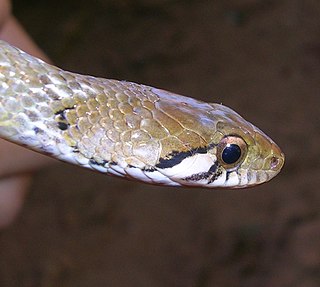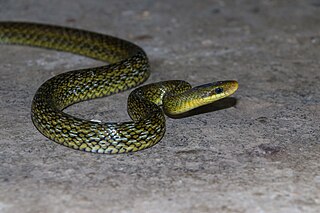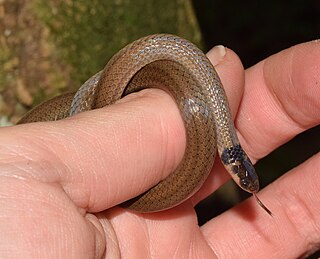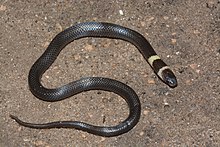
The Nilgiri keelback, also known commonly as Beddome's keelback, is a species of snake found in the Western Ghats in India. The species is named after Richard Henry Beddome, 1830–1911, British army officer and naturalist. It was first discovered near the Nilgiris but is now known more widely from the Western Ghats. This snake is terrestrial and feeds on toads.

The banded racer or banded wolf snake, is a species of colubrid snake.

Elaphe hodgsoni, the Hodgson's rat snake, is a species of snake in the family Colubridae. The species is found in parts of Asia around the Himalayas.

Sibynophis collaris, commonly known as the common many-toothed snake,Betty's many toothed snake or the collared black-headed snake, is a species of colubrid snake endemic to South and East Asia.

Hydrophis melanocephalus, commonly known as the slender-necked sea snake, is a species of venomous sea snake in the family Elapidae.

Macrelaps is a monotypic genus created for the rear-fanged (opisthoglyphous) venomous snake species, M. microlepidotus, endemic to South Africa. No subspecies are currently recognised.

Amblyodipsas unicolor, commonly known as the western glossy snake or the western purple-glossed snake, is a species of rear-fanged snake in the family Atractaspididae. It is one of the better known species in the genus Amblyodipsas.
Aparallactus lineatus, or the lined centipede-eater, is a species of mildly venomous rear-fanged snake in the family Atractaspididae.
Aparallactus niger is a species of mildly venomous rear-fanged snake in the family Atractaspididae. It is endemic to Western Africa.
Polemon acanthias, or Reinhardt's snake-eater, is a species of mildly venomous rear-fanged snake in the family Atractaspididae. It is endemic to Africa.
Polemon barthii, or the Guinea snake-eater, is a species of rear-fanged mildly venomous snake in the family Atractaspididae. The species is endemic to Africa.

Polemon collaris, or the collared snake-eater, is a species of mildly venomous rear-fanged snake in the family Atractaspididae. It is endemic to Africa.
Polemon gabonensis, or the Gaboon snake-eater, is a species of mildly venomous rear-fanged snake in the family Atractaspididae. It is endemic to Africa.

Polemon notatus is a species of mildly venomous rear-fanged snake in the family Atractaspididae. It is endemic to Africa.

Aparallactus capensis, or the Cape centipede-eater, is a species of mildly venomous rear-fanged snake in the Atractaspididae family.
Aparallactus jacksonii, or Jackson's centipede-eater, is a species of mildly venomous rear-fanged snake in the family Atractaspididae.

Aparallactus lunulatus, or the reticulated centipede-eater, is a species of mildly venomous rear-fanged snake in the family Atractaspididae, which is endemic to Africa.

Aparallactus modestus, or the western forest centipede-eater, is a species of mildly venomous rear-fanged snake in the Atractaspididae family.
Aparallactus nigriceps, or the Mozambique centipede-eater, is a species of mildly venomous rear-fanged snake in the family Atractaspididae.
Aparallactus werneri, or the Usambara centipede-eater, is a species of mildly venomous rear-fanged snake in the family Lamprophiidae. The species is endemic to Tanzania.












